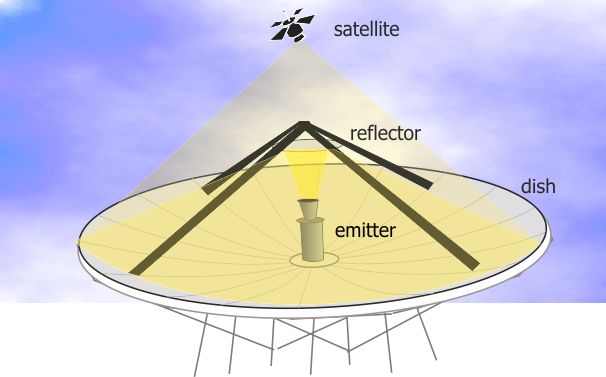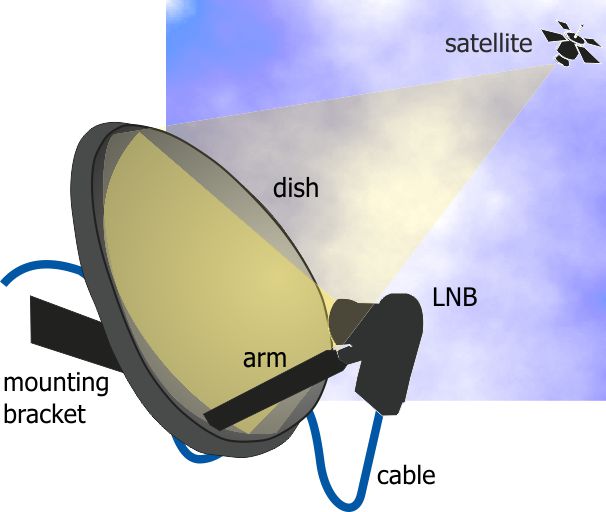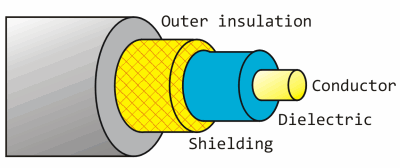Freesat reception - all about dishes
 Brian Butterworth published on UK Free TV
Brian Butterworth published on UK Free TV Satellite reception has both advantages and disadvantages compare with terrestrial (aerial) reception.
By using much higher frequencies (gigahertz, compared to terrestrial televisions megahertz) more transmission channels called transponders (the satellite equivalent of multiplexes) can be provided. For example, there are only six Freeview multiplexes, but Sky or Freesat users can access two hundred satellite transponders.
Aside from exceptional weather conditions (very heavy rain for example) digital satellite provides stable pictures and audio. Where Freeview transmitters are no more than 732 metres above sea level, the geostationary satellites used for television are 35,800,000 metres above the equator so reception is possible even where buildings, trees and hills make terrestrial reception impossible.

The downside of the transmitters being 22,300 miles up in the air is that the signals are very, very weak - so standard TV aerial is of little use. When the signals are sent to the satellites, huge dish transmitters are used to uplink the signal to the satellite. These are tens of metres from side to side, and feature an emitter that generates the signal, which is first bounced of a mirror (called a reflector) and then off the surface of the parabolic dish.

There are many satellites in the sky over the equator. Often these are in clusters over a particular position, for example there are four used for UK television are at 28.2 degrees east. There is another cluster over the 19.2 degrees east positions that are used for German television.
To receive these very weak signals from the satellite, it is necessary to use a dish for reception too. By using a reflective dish, this concentrates the signals onto a small device called a LNB. This is held in front of the dish by a metal arm.

The size of dish for reception is typically much smaller; often 60cm to 100cm in diameter, but the exact size depends upon the transmitting satellite transponder. To keep the transmission power levels down to levels that can be powered by the satellite's solar panels, each beam is focused on a particular area of the Earth's surface. If you are trying to receive the signal at the centre of this zone, a small dish is required. At the outer edges, you may need a 5 metre dish. Maps of these zones are provided by the satellite companies, and are called satellite footprints.
When the dish is installed it must be aligned carefully as the signal is very weak. The installer needs to know the inclination and the azimuth from the ground location to the satellite. If you install yourself you will find that there are markings on the dish that are used to point the dish in the correct position. It is important that the view of the satellite will not be blocked, so must take into account leaves growing on trees and potential building works.
For many people the LNB will have a single cable connected to it, however if you have Sky+ or a multi-room installation the LNB package will actually contain four receivers a quad-LNB. Unlike terrestrial television where you can split the aerial cable to feed more than one Freeview box or television set, with satelite reception you cannot. So, a Sky+ box with two receivers (so you can watch one thing and record another) has two cables connecting the box to the dish.
The cable that connects the dish to the receiver must be satellite grade cable. Whilst this looks superficially like the cable used to connect and aerial to a television, a higher grade cable is required for satellite reception.
Here is an image of a co-axial cable. This sort of cable is used to connect any type of receiving aerial to the reception equipment.

RG6, PF100 and PH100 are all types of coax cable that are suitable for the very weak signals that are received by a satellite dish. (The power is the same as you would receive from a one-bar electric heater on the moon).
The conductor in the centre passes the signals received from the dish to the set-top box. This is made from steel in RG6 cable, and from copper in the RF100 and PH100 types. This makes RG6 less suitable in the UK where rain can damage the cable.
The shielding is responsible for keeping unwanted external interference from damaging the signal. In the cheaper cable this will be a foil wrap, in better specified cables this is a braid (or mesh) of copper wires. The sheild in the RF100 covers 58% of the cable.
The non-conducting layer between the shield and the conductor is called the dielectric. This can be either a solid (RG6), foam (RF100) or air-spaced (PH100) dielectric. This makes the cables progressively more flexible (ie bendy without damage).
6:56 PM
P>S> Henry, If your thinking of additional receiver(s) following your alterations , then best to upgrade the four output LNB to an OCTO eight output LNB - not an expensive item. Dependent on the SKY dish you may also need a suitable plastic adapter with a 40mm collar for an OCTO LNB . about £3 to £4.-
| link to this comment |
10:37 AM
Hi, I am ignorant of satelite systems
We are moving to a new home which has a satelite dish outside the kitchen
We will not need satelite, could I use the dish as a TV aerial for a kitchen television by running a cable from it into the kitchen ?
Many thanks
Greg
| link to this comment |
11:03 AM
Greg Mullins - The dish requires connection to a satellite receiver Greg. You could get your self a standard definition "Freesat" receiver from Argos and just plug it in to
give TV in the kitchen. "Freesat" is supported by the BBC and ITV and is non-subscription. Receiver costs £29.99 amd is straightforward to connect.
| link to this comment |
5:22 PM
Greg Mullins - Greg, whilst the dish at your new house is located outside the kitchen it's likely that it will having wiring from it to a point in your lounge. Setting up a secondary connection to a receiver and TV in the kitchen isn't an expensive upgrade which can be done by a local installer. Worth checking to see if a cable has been run to the kitchen in which case as noted above, it's a straight forward eet up task.
| link to this comment |
6:40 PM
Sheffield
The FREESAT/SKY ITV regions are a mystery. We live in Sheffield and would get Yorks W service with an aerial. Sky used to put that on EPG but a few months ago changed it to Yorks E - the Lincolnshire service. Mum in Nottinghamshire gets this too. Friend in Notts put a Nottingham postcode in his FREESAT to trick it to give him Central E but bizarrely it gives him Cenral W. I gave him the frequencies to tune manually but I wonder why you can't just choose your own regions for BBC and ITV
| link to this comment |
Steve's: mapS's Freeview map terrainS's terrain plot wavesS's frequency data S's Freeview Detailed Coverage
8:56 PM
Hi, I have just moved to a new house and it only has a single LNB on the sky dish, my mate has a quad LNB can i just put it onto my sky dish at my new home, im currently using Freesat. any answers?
| link to this comment |
8:36 AM
Alexis Brown - In general terms yes. - You may have a problem if the LNB adapter doesn't match and you may need to change this to one that suits. They are inxpensive and can be had on auction sites, although if you have a satellite shop near you then probly best to acquire there to get a proper match.
| link to this comment |
Steve: There is no mystery at all.
The Freesat (and Sky, just by their database) postcodes set up the regions that match the analogue transmitter network, so you get region an analogue aerial would have got before switchover.
Many homes in Nottingham were primarily served by Sutton Coldfield.
| link to this comment |
4:29 PM
Reading
Steve: Not all ITV regions are available on Freesat - some are only broadcast encrypted (free-to-view with Sky equipment and a Sky viewing card). The following micro-regions are only available to Sky subscribers:
Anglia West
Central East
Central South (Thames Valley North)
Central South West
Meridian North (Thames Valley South)
Meridian Sussex
Tyne Tees South
Yorkshire East
Some of these now only differ by the adverts shown. Central South and Meridian North (which briefly made up the non-franchise Thames Valley area) get the Meridian South news service and I believe Meridian Sussex gets Meridian South-East.
Yorkshire and Anglia appear to no longer runs separate west/east news services. The only loser as far as I can see is Central East.
For some reason Anglia has two free-to-air streams: East and South. They could probably scrap one of these to get Central East free-to-air - if they wanted to.
If you have Freesat, you will be given the nearest ITV micro-region that is broadcast free-to-air. I don't know the exact rules.
| link to this comment |
Mike's: mapM's Freeview map terrainM's terrain plot wavesM's frequency data M's Freeview Detailed Coverage
6:56 PM
Sheffield
Mike - thanks for the info.
Briantist - thanks for that contrbution. The truth is that my mate put in a Nottingham postcode to try and trick Freesat. An NG17 postcode usually brings up Yorks E. I'll find out the postcode of the transmitter itself!!
| link to this comment |
Steve's: mapS's Freeview map terrainS's terrain plot wavesS's frequency data S's Freeview Detailed Coverage